I’m a meat and potatoes guy. But I’m also a nosey guy. So even though I don’t eat a lot of fruit, there are some fruits I’ve always been dying to try. Simply because I’m an inquisitive foodie.
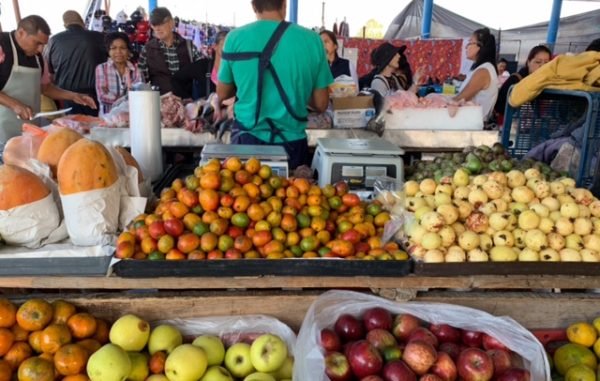
You might have been there. Walking through a Mexican fruit and veg market when some array of traffic light colors catch your eye. Those look tasty you think. But what do I do with them? Do I peel them, stew them, pit them, juice them?
Sometimes they have signs on them. Exotic words that make you want to finally learn how to roll your rrrrrrrrs. Words like carambola and ciruela. Words like guayaba and guanabana, zapote and chicozapote. When I see or hear their names, my curiosity just grows and grows and grows.
So what if you could walk through a door of a restaurant and taste so many of those mystery fruits with the restaurant doing all the necessary nasty picking, pitting and peeling for you. That’s what I did in San Miguel de Allende recently.
There’s a new restaurant in town and it has the biggest fruit drink list I have ever seen. The restaurant is part of a chain, a very fast growing chain. They’ve rocketed from one to 22 locations in less than six years. They have another ten locations in the coming soon section of their menu.

What I liked about the restaurant most was it didn’t look like it was part of a chain, inside or out. There was no slickness to the exterior, just a simple wooden sign saying Ojo de Agua and a dark stone doorway festooned with colored ribbons. Inside, there was a warm, casual and friendly feeling to the restaurant and staff that again avoided the slick look of the typical fast food chains.
There was a typical restaurant chain experience the first time I went to Ojo de Agua: The need to line up at a counter and place your order in order to receive your food and drinks (by my third time there though they were also offering table service). Lining up at a counter isn’t such a hardship you may think, particularly if you are one of the 37% of American adults that eat fast food every day, but then you see Ojo de Agua’s 15 different blackboards, all with different possibilities, and it’s bewildering. There are almost 50 different dishes and over 50 different drinks to choose from.
What intrigued me most was a little blackboard with the title Jugos Clasicos. Strange, I thought, that there was no orange, no apple, but even stranger were the juices that were there, juices that I’d never had in my life…higo, litchie and mora azul.

Then things got even more complicated. I picked up a gatefold menu from the counter and there, staring at me, was an even bigger English-language list of classic juices. Not only fig, lychee and blueberry but a lot of very Mexican fruits that I had never in my life drank the juice of. There were even two that I had never eaten the flesh of. But did I ever want to.
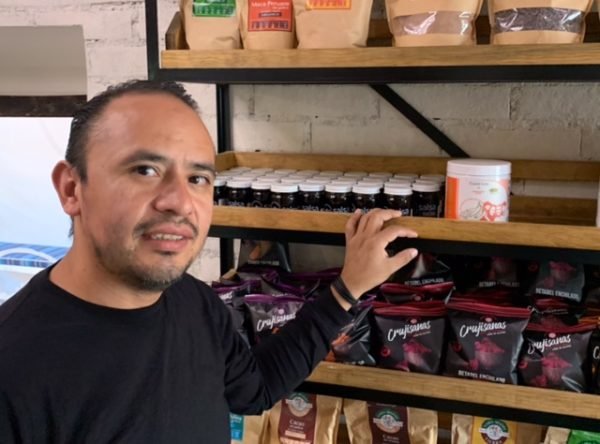
I spoke to Jonathan, the manager of San Miguel’s Ojo de Agua and asked him what else went into their classic juices.
“Nothing, absolutely nothing, not even any sugar”, Jonathan told me. “Everything is natural. All the sweetness is from the fruit…well I shouldn’t say absolutely nothing. We sometimes have to add water but only to make it liquid enough to pour and drink.”
“And do the juices all come up from a commissary in Mexico City?”, I asked.
“No, they’re made right here in our kitchen”, Jonathan replied. “We have a giant press in the kitchen and every morning our chefs squeeze away.”
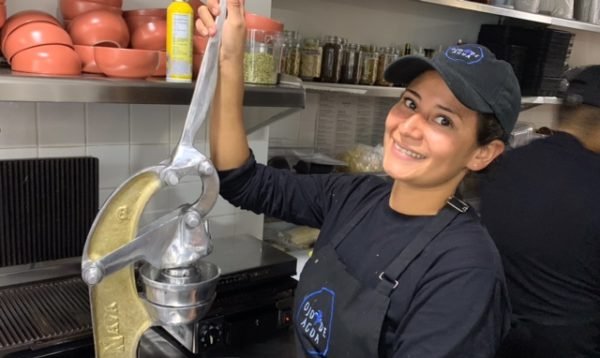
I decided on seven juices, all from fruit native to Mexico, that I wanted to try. I quickly discovered that two of them, zapote and chicozapote were seasonal and this wasn’t the season. Ojo de Agua was also currently out of tuna (prickly pear) so I struck that off my list. I settled on mamey, guanabana, papaya and guayaba then, upon the recommendation of manager Jonathan, made one more late addition from another list of mostly mixed juices called Funcionales that combined the Mexican fruit called lima with honey.
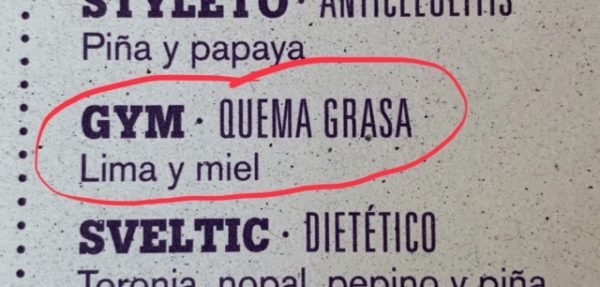
“It’s not on the classic juices list because we have to add a sweetener to the lima or it would be too sour”, Jonathan told me.
Guayaba
On our first visit, Don Day’s Wife and I tried what in Mexico is called the guayaba and what I was more used to calling a guava. Before I tell you how it tasted though, let me apologize. Let me tell you how difficult it is to describe the taste of a fruit. Think about it; try to tell someone who’s never had a banana or a cherry what they taste like.
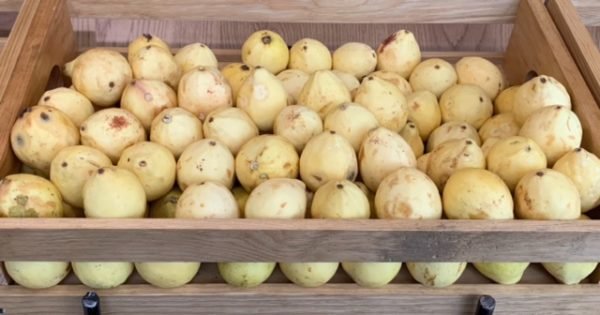
Maybe because I’ve been to too many wine tastings, I started by dipping my nose in the glass. I got lemon and a musky odor, but musky in a nice way.

The frothy juice is a pale, creamy yellow in color. There were a lot of fruit flavors in Ojo de Agua’s guayaba juice. It was sweet but it was also a little sour. Strawberry hit me first, then pear, peach and a little grapefruit. When I swished the creamy, custardy liquid around in my mouth, I also get hints of banana and coconut.

Guayaba juice also made it to our home and Don Day’s Wife thinks by mixing it with two parts Prosecco, she may now be the inventor of the next Bellini. Those who prefer their juices in the morning might want to feature it in a smoothie.
I will buy Ojo de Agua’s guayaba juice again.
Papaya

I was on my own, the next time I was at Ojo de Agua. I like papaya; Don Day’s Wife doesn’t. I planted a papaya tree in our garden; I told Don Day’s Wife it was for the smell from the flowers. I was right because some unknown animal devours the fruit about a week before it’s ripe enough to eat. Of course, I ordered the papaya juice at Ojo de Agua.
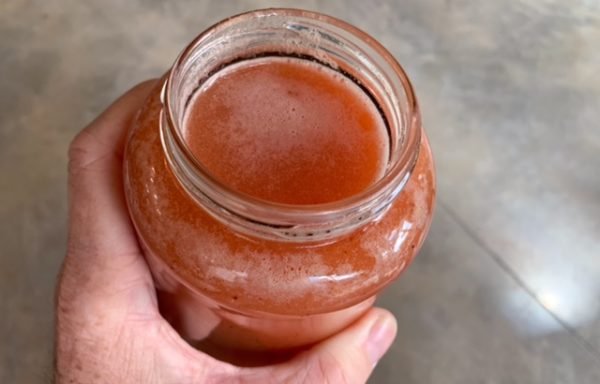
I’m sure you know what papaya tastes like so I won’t even attempt a description. What I will tell you is that an entire glass of it was a little too much, a little too rich, a little too sweet.
Even when I have the fruit, I want some cereal, maybe some cream. I’m going to skip the juice from now on.
Guanabana
I remember the first time I picked up…or tried to pick up a guanabana…it must have weighed at least five pounds. I’d been almost afraid to touch it thinking I might end up pulling thorns out of my palms but, fear not, the bark of the guanabana spikes is worse than their bite.
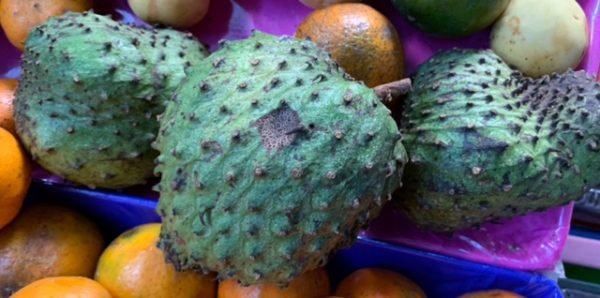
In Toronto’s Asian markets, they call them soursops but they definitely originated in Mexico. The seeds of the guanabana remind me of the way watermelons used to be and, with the spitting that was required, they were only for outdoor eating. A juice therefore seemed like the best way to enjoy guanabana.
There’s strawberry and grape in the taste of the milky white juice but what had me really excited was the hint of tomato and cucumber. This was the least sugary of all the juices which I also found appealing. After taking an order home (plaudits to Ojo de Agua’s super sturdy “to go” cups) and introducing it to another juice called Smirnoff’s it was even better.
As mentioned, in some parts of the world, guanabana gets called soursop which helps explain its appeal to me. I have much more of a savory than sweet palate and guanabana has a very appealing, tangy, citric, sour bite to it.
Mamey
I was in my eighth decade before I ever tasted mamey zapote (sometimes spelled sapote). It was worth the wait. If you’ve never tried and are intrigued by the fruit, you can read about it here:
As I wrote in that blog post (somewhat tongue in cheek), describing the taste of a mamey zapote isn’t that difficult. Start with sweet potato, then add a little pumpkin and papaya with a little bit of cherry and you’ll be fairly close. Add hints of chocolate, almonds and vanilla and you’ll be even closer.

When I saw mamey on Ojo de Agua’s Classic Juices list, I couldn’t resist ordering it. My reaction to the taste was a lot like my response to papaya juice: Too much of a good thing…a little too rich, a little too sweet.
I didn’t finish my mamey zapote juice so once again asked the very accommodating staff for one of their “to go” cups. It was a lot better, a lot more refreshing, mixed 50/50 with Seven Up.
Lima
I’ve always felt sorry for the lima. How you could not feel sorry for something called the bastard fruit? Everyone agrees that limas are a hybrid but no one’s exactly sure who its parents are. Probably a lemon and a lime but which lemon and lime no one is sure.
The first time I came across the lima was a lot of years ago when I ordered sopa de lima at the Yucatan-inspired San Miguel restaurant La Casa Del Diezmo. I thought it was a typo on the word lime until I got home and put it into a Google search.
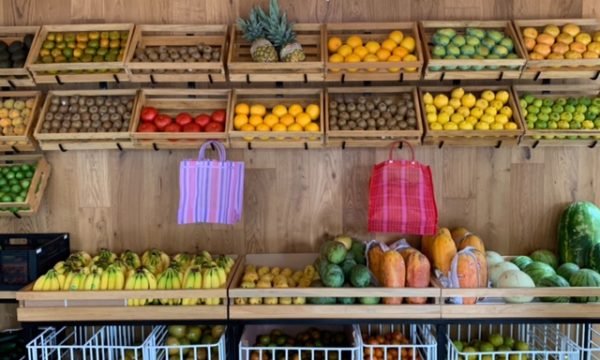
Ojo de Agua not only sells juices, they sell fresh fruit and vegetables. Usually when I see limas it’s at San Miguel’s Ignacio Ramirez Market where a stall might have five or ten. At Ojo de Agua, they have two large racks of them.
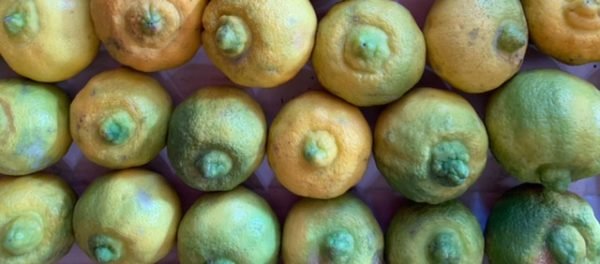
I enjoyed the lima and honey drink but after a few sips, I’d had enough. But I do have a recommendation of how else you might experience the taste of lima. Ojo de Agua is experimenting with adding alcohol to their offerings and San Miguel de Allende is one of their test markets. The lima y miel would be very, very nice, replacing the lime juice and sugar syrup in a margarita.
Oja de Agua’s juices come in three sizes. They call them small, medium and large. They would more appropriately be called enormous, ginormous and humongous. The large is just under a litre; even the small is over half a litre. So perhaps my strongest drink recommendation at Ojo de Agua is to not go alone, go with at least one other person and share.
On my next visit to Ojo de Agua I’m going to start working on the Combinaciones. Coconut, mango and passion fruit. Guanabana, pineapple and strawberry. Rambutan, coconut and pineapple. Decisions, decisions, decisions.

Ojo de Agua is located at Pila Seca 32 in San Miguel de Allende, Mexico. The restaurant is open from 8:00 am to 8:00 pm, Sunday through Thursday; 8:00 am to 10:00 pm, Friday and Saturday.


I’m really happy to hear this! We’ve enjoyed going to Ojo de Agua’s Condesa location for years, and it’s great to have one of our own.
I love this place….. The food is tasty also. But the fruit juice!!!!! Durazno is my fav. Must sample the more exotic flavors. And you are right about the sizes of the juices.
And the pulled turkey sandwich was brimming with tasty pine nuts. Everything on the menu is large enough to share. Who wants to share a wagyu beef hamburger with me?
We are thrilled that Ojo de Agua is here in San Miguel. We have been going for years to the one in Condessa. The breakfasts are great too!